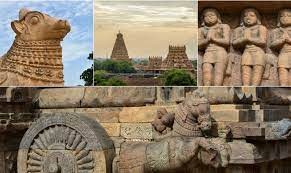Published on: June 16, 2023

ARCHITECTURE UNDER THE CHOLAS
ARCHITECTURE UNDER THE CHOLAS

- The Cholas, one of the longest-ruling dynasties in the region, left behind a rich legacy of artistic and architectural masterpieces that continue to captivate people to this day.
Highlights:
- The Chola kings built many temples throughout their kingdoms and temples of early Cholas are found in large number in the former Pudukottai region.
- These Chola temples reveal the gradual evolution of the Chola art and architecture.
- The Chola kings earlier built brick temples and later they built stone temples.
Special features of Chola Architecture
- The Cholas followed the Pallava style of architecture.
- Sanctum of the Chola temples are both circular and square in size.
- Inner side of the external walls and the sanctum were beautified and the upper side of the sanctum special vimanas are built.
- Dome shaped sikhara and kalasa were also there on the top of Gopurams.
- Chola temples are noted for the sculptures and ornamental works.
- Many temples are having pillared mandapams namely arthamandapa, mahamandapa and nandi mandpa.
- Sculptures and inscriptions are also fixed on the walls of these temples.
Sculpture
- Stone and metal sculptures are found in plenty in Chola temples.
- They depict the socio religious ideas of the Chola period ,Nataraja sculpture is world famous not only for its beauty but also for its spiritual meaning.
- Vishnu idol is placed in Vaishnava temples, spiritual calmness is depicted in sculptural representations of Alwars.
- Realism dominated sculpture of the Chola period. Scenes from Ramayanam Mahabharatam, Puranas and lives of the 63 Nayanmars are sculptured in narrative panels on the walls of temples.
Portraits
- The Cholas excelled the Pallavas in the art of portrait making.
- The best specimens of portraits are found on the walls of Koranganatha temple and Nageswarasamy temple.
- The portraits of Cholamadevi and Kulothunga-III are there in Kalahasti temple are good examples of Chola art of portrait making.
Frescoes and Paintings:
- The Cholas also incorporated vibrant frescoes and paintings in their temples, although only fragments of these artworks remain today. These paintings depicted religious narratives, divine beings, and daily life scenes, providing insights into the cultural and social context of the time.
Temples of cholas
- The greatest landmark in the history of south Indian architecture is Brihadeeswarar temple at Tanjore and also called as big temple built by Rajaraja I. This is the largest and tallest temple in Tamil nadu and the Airavatesvara Temple in Darasuram, constructed by King Rajaraja Chola II. These temples are UNESCO World Heritage Sites today.
- King Kulothunga I built a temple for Sun God at Kumbakonam. This temple is first of its kind in the south Indian architecture.
Technological Advancements:
- The Cholas made significant technological advancements in construction techniques. They developed efficient systems for quarrying, transporting, and erecting massive stone blocks, enabling the construction of grand temples and monuments.
Cultural Influence:
- The Chola Empire had extensive trade and cultural contacts with other regions, including Southeast Asia. The architectural and artistic styles of the Cholas influenced the kingdoms of Southeast Asia, particularly in Cambodia and Indonesia, leaving a lasting impact on their own art and architecture.
Conclusion
- The continuous improvement and refinement of Chola art and architecture during the imperial period can be attributed to the Cholas’ vision, patronage, technological expertise, and cultural exchange. Their artistic achievements stand as a testament to the enduring legacy of the Chola dynasty in South India and its contributions to world art and architecture.
- The glorious Chola culture created very big impact on Tamil society and imbibed lot of cultural values like bhakti upon the Tamil society.

